Introduction: The Hidden Revenue Leak
Every digital touchpoint represents a potential revenue opportunity, yet the vast majority of businesses operate with conversion rates that barely scratch the surface of their true potential. Consider this sobering reality: while the median conversion rate across industries hovers around 2.3%, top-quartile performers consistently achieve rates exceeding 4%. This disparity represents more than statistical variance—it reflects a fundamental gap in understanding how human psychology, technical optimization, and data-driven methodology converge to create extraordinary business outcomes.
The Anatomy of Conversion Rate Optimization
Conversion rate optimization transcends the superficial notion of “making things look better” or implementing random A/B tests. At its core, CRO represents a systematic, scientific approach to understanding why visitors behave as they do and methodically removing the friction that prevents them from taking desired actions. This discipline requires equal parts analytical rigor, psychological insight, and technical proficiency.
The most sophisticated practitioners recognize that every conversion event exists within a complex ecosystem of user motivations, contextual factors, and decision-making heuristics. When we examine high-performing conversion funnels, we consistently observe certain patterns: clarity of value proposition, reduction of cognitive load, strategic deployment of social proof, and alignment between user intent and interface design.
The Psychology of Digital Decision-Making
Understanding conversion optimization requires appreciating how humans make decisions in digital environments. Unlike traditional retail environments where customers can physically interact with products and rely on sales personnel for guidance, digital conversion depends entirely on the interface’s ability to communicate value, build trust, and guide behavior.
Three fundamental psychological principles govern digital conversion behavior. Loss aversion theory suggests that people are approximately twice as motivated to avoid losses as they are to acquire equivalent gains. This principle explains why urgency messaging, limited-time offers, and risk-reversal guarantees often produce significant conversion improvements. Social proof leverages our inherent tendency to look to others’ behavior as validation for our own decisions, particularly in uncertain situations. Finally, cognitive load theory demonstrates that every additional piece of information, choice, or step in a process creates mental burden that can derail conversion intent.
The Data Infrastructure Imperative
Sophisticated conversion rate optimization requires robust data infrastructure that extends far beyond basic analytics tracking. The most effective CRO programs integrate multiple data sources to create comprehensive user behavior profiles: quantitative analytics reveal what users do, qualitative research explains why they do it, and technical performance data identifies where systems create friction.
Modern CRO practitioners employ advanced attribution modeling to understand how different touchpoints contribute to conversion outcomes. This multi-touch attribution approach recognizes that conversion rarely results from a single interaction but rather emerges from a series of influence events across various channels and timeframes. Without this holistic view, optimization efforts often focus on symptoms rather than root causes.
The Methodology That Separates Leaders from Followers
Elite conversion optimization follows a systematic five-stage methodology that ensures both statistical validity and business impact. The process begins with comprehensive audit and baseline establishment, where analysts map complete conversion funnels, identify drop-off points, and establish performance benchmarks across relevant segments.
Hypothesis development transforms raw data into testable propositions grounded in behavioral theory and business logic. The most effective hypotheses combine quantitative insights with qualitative understanding, creating clear predictions about how specific changes will influence user behavior. This stage requires sophisticated prioritization frameworks that balance potential impact, implementation complexity, and statistical requirements.
Experiment execution demands technical precision and statistical rigor. Proper test design considers sample size requirements, segment-specific behavior patterns, and temporal factors that might influence results. The most successful practitioners maintain testing velocity while preserving statistical integrity, recognizing that both speed and accuracy contribute to program success.
Implementation and Continuous Intelligence
Winning experiments only create value when properly implemented and monitored for long-term performance. This stage requires careful coordination between optimization teams, development resources, and quality assurance processes. The most sophisticated practitioners also consider how conversion optimizations interact with other business systems, particularly SEO performance and paid advertising efficiency.
Continuous intelligence transforms individual test results into strategic business insights. This involves building predictive models that forecast optimization impact, creating anomaly detection systems that identify performance changes, and developing frameworks that guide future optimization priorities. The goal extends beyond improving individual metrics to building organizational capability for sustained conversion improvement.
Industry Benchmarks and Performance Standards
Understanding relative performance provides crucial context for optimization efforts. B2B SaaS companies typically observe median conversion rates around 2.3%, with top-quartile performers achieving rates above 4%. E-commerce retailers generally see median rates near 2.0%, with leading performers reaching 3.8% or higher. However, these benchmarks represent starting points rather than destination targets, as the most successful businesses focus on continuous improvement relative to their own baseline performance.
The Technology Stack That Powers Elite Performance
Modern conversion rate optimization relies on sophisticated technology infrastructure that integrates analytics platforms, testing tools, customer research systems, and business intelligence solutions. Google Analytics 4 provides foundational user behavior data, while specialized platforms like Mixpanel offer more granular event tracking capabilities. Heat mapping tools such as Hotjar reveal user interaction patterns that pure analytics cannot capture.
Testing platforms like Optimizely enable rapid experiment deployment while maintaining statistical validity. Advanced practitioners also leverage customer research tools, predictive analytics platforms, and custom data visualization solutions to create comprehensive optimization insights.
Conclusion: The Competitive Advantage of Systematic CRO
Businesses that approach conversion rate optimization with scientific rigor and systematic methodology consistently outperform those that rely on intuition or ad-hoc testing. The difference lies not in individual tactics but in organizational commitment to understanding user behavior, maintaining data integrity, and continuously refining digital experiences based on evidence rather than assumptions.
The opportunity for dramatic improvement exists across virtually every industry and business model. Companies that invest in proper CRO methodology often achieve conversion improvements of 25-40% within the first year, with sustained gains continuing as optimization capabilities mature. This represents not just improved marketing efficiency but fundamental enhancement of business model sustainability and growth potential.

